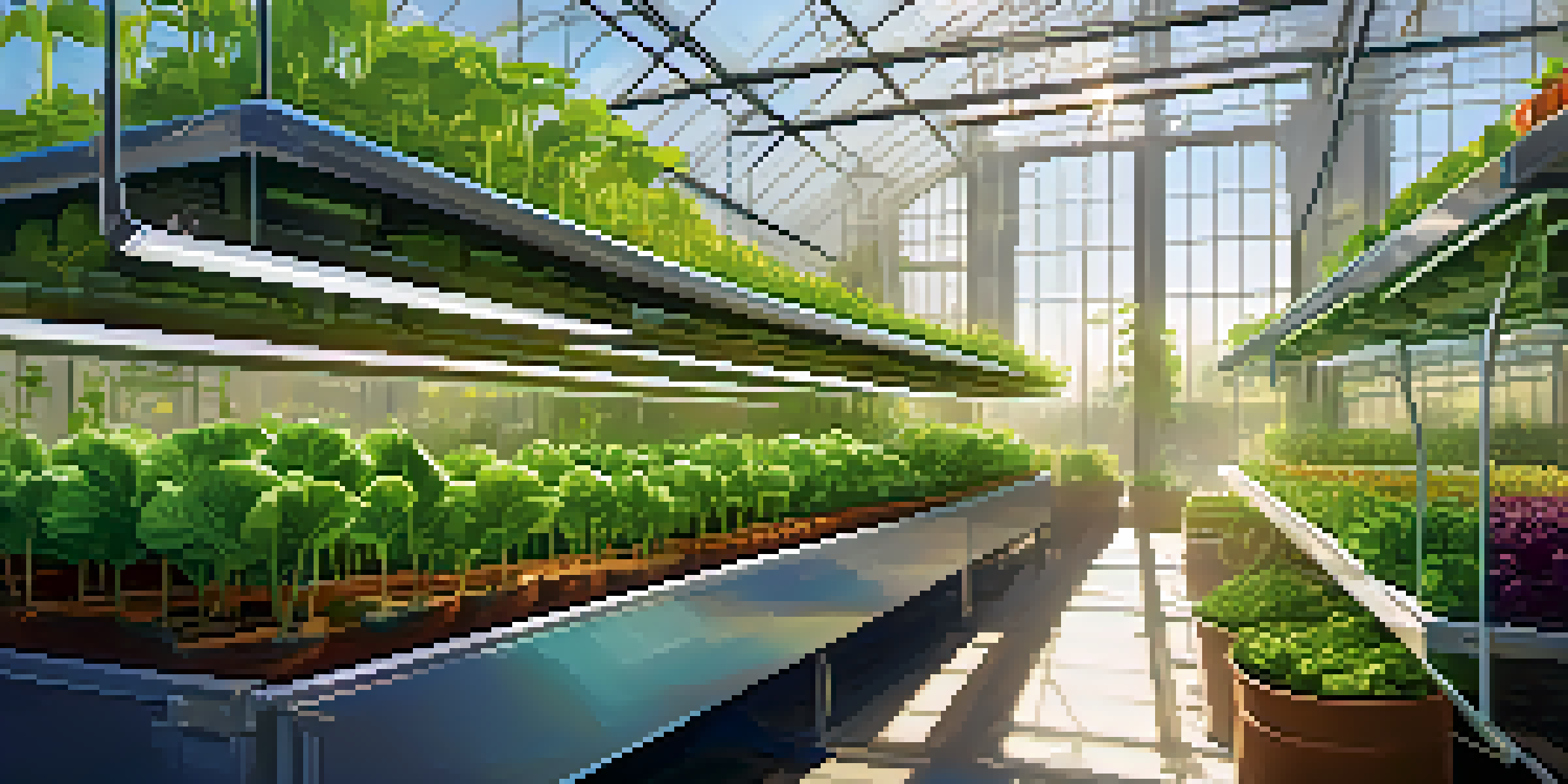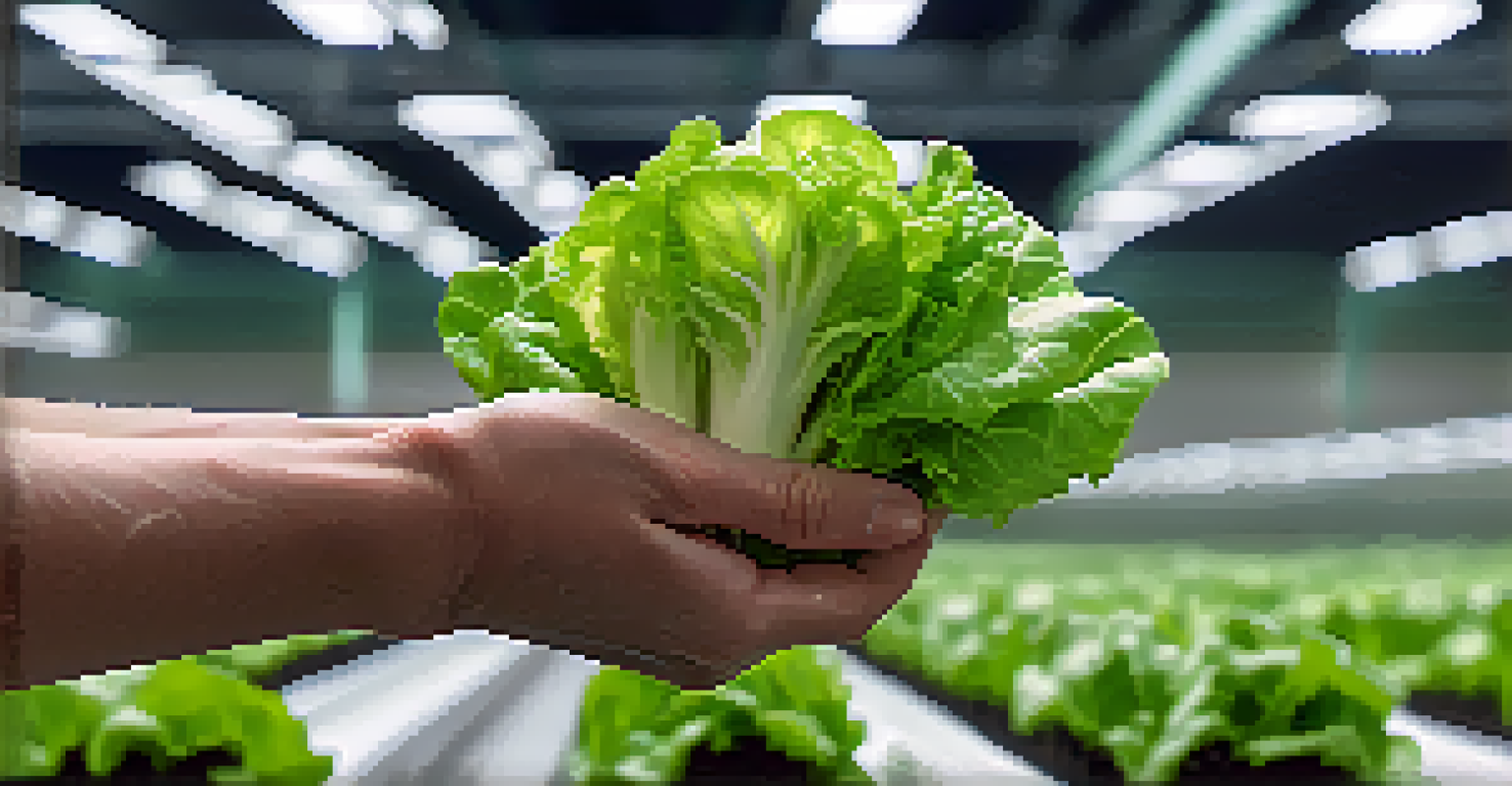The Benefits of Hydroponics in Controlled Environments

Hydroponics: An Introduction to Soil-less Growing
Hydroponics is a method of growing plants without soil, using nutrient-rich water instead. This technique allows for precise control over growing conditions, making it an ideal choice for controlled environments such as greenhouses. By eliminating soil, farmers can also reduce pests and diseases, leading to healthier plants and higher yields. It's like giving plants a perfectly tailored diet, ensuring they get exactly what they need to thrive.
The future of food is not about farming in the field, but farming in the city.
With hydroponics, the roots of plants are submerged in a nutrient solution, allowing them to absorb water and nutrients directly. This method not only speeds up growth but also conserves water, using up to 90% less compared to traditional farming. Imagine being able to grow fresh vegetables with minimal water usage – that’s the magic of hydroponics.
Moreover, hydroponics enables year-round cultivation, independent of seasonal changes. This means that farmers can produce crops continuously, providing a steady supply of fresh produce regardless of the weather. It's a game-changer for food production, especially in regions with harsh climates.
Maximizing Space Efficiency with Vertical Hydroponics
One of the standout benefits of hydroponics is its ability to maximize space, particularly through vertical farming techniques. By stacking plants in layers, growers can produce more food in less area, making it perfect for urban environments where space is a premium. Think of it as the difference between a sprawling traditional farm and a compact, multi-story building dedicated to growing food.

Vertical hydroponics also allows for better air circulation and light exposure, which can enhance plant growth. When plants are arranged vertically, they can take full advantage of artificial lighting, ensuring they get the energy they need. This means that even in small spaces, you can have a flourishing garden.
Soil-less Growing Enhances Control
Hydroponics allows for precise control over growing conditions, leading to healthier plants and higher yields.
This innovative approach can significantly increase yields per square foot, making hydroponics a highly efficient farming method. For urban dwellers or anyone looking to optimize their growing conditions, vertical hydroponics offers a viable solution that combines productivity with limited space.
Water Conservation: A Key Advantage of Hydroponics
Water scarcity is a growing concern worldwide, and hydroponics offers a practical solution. By using a closed-loop system, hydroponic farms recycle water, minimizing waste. This means that every drop counts, and farmers can grow crops using significantly less water than traditional agriculture.
Hydroponics is a way of growing food that respects the limits of our planet while still meeting our needs.
In fact, hydroponics can use up to 90% less water than conventional farming methods. Since the water is recirculated and reused, the system only needs to replenish what the plants absorb. This conservation is crucial, especially in areas facing drought or limited water resources.
Additionally, the precise control over nutrient delivery in hydroponics means that plants can be more efficient in their water use. This not only benefits the environment but also leads to healthier plants, ultimately resulting in better quality produce for consumers.
Quality Control: Consistent Produce with Hydroponics
Controlled environments allow for meticulous quality control, a significant benefit of hydroponics. Growers can monitor and adjust factors such as pH, temperature, and nutrient levels, leading to consistent and high-quality produce. It's akin to having a laboratory dedicated to growing food, where every variable can be fine-tuned.
With hydroponics, plants are less susceptible to pests and diseases, as they are grown in a sterile environment. This not only reduces the need for chemical pesticides but also results in cleaner, healthier food. Consumers can enjoy fruits and vegetables that are not only fresh but also free from harmful residues.
Water Conservation Revolution
This method can use up to 90% less water than traditional farming, making it a sustainable choice for agriculture.
Moreover, the ability to grow crops year-round means that the quality of produce can be maintained regardless of seasonal variations. This consistency is appealing to both growers and consumers, ensuring that fresh, high-quality food is always available.
Reducing Environmental Impact Through Hydroponics
Hydroponics has the potential to lessen the environmental impact of agriculture significantly. Traditional farming often involves extensive land use, soil degradation, and significant transportation emissions. In contrast, hydroponics can be implemented in urban areas, reducing the need for long-distance transportation of food.
By growing food closer to consumers, hydroponics supports local economies and decreases carbon footprints. Imagine fresh greens grown just a few blocks away instead of being shipped from hundreds of miles away – that’s the environmental win of hydroponics.
Additionally, the reduced need for pesticides and herbicides in hydroponics leads to less chemical runoff into our waterways. This not only protects aquatic ecosystems but also contributes to cleaner, healthier environments for everyone.
Nutrient-Rich Crops: Enhancing Food Quality with Hydroponics
One of the remarkable aspects of hydroponics is the ability to produce nutrient-rich crops. Because growers can customize nutrient solutions, they can enhance the nutritional content of the produce. This means that consumers can enjoy fruits and vegetables that pack more vitamins and minerals than their traditionally grown counterparts.
For instance, by adjusting the nutrient mix, hydroponic farmers can boost the levels of antioxidants in their crops. This not only benefits health-conscious consumers but also makes hydroponic produce more appealing in the marketplace.
Sustainable Future for Food Production
Hydroponics supports sustainable agriculture by reducing land use and minimizing environmental impact.
Moreover, the fresh, clean environment in which hydroponics operates often leads to better taste and texture. When plants are healthy and well-nourished, they produce flavors and qualities that are hard to beat, making hydroponics a win-win for both health and flavor.
The Future of Food: Hydroponics and Sustainable Agriculture
As the global population continues to rise, the demand for sustainable food production methods becomes increasingly urgent. Hydroponics stands at the forefront of this movement, offering solutions that align with the principles of sustainability. It's a way of growing food that respects the limits of our planet while still meeting our needs.
With advancements in technology, hydroponics is becoming more accessible and efficient. Innovations such as automated systems and smart sensors are making it easier for growers to monitor and manage their crops. This not only enhances productivity but also encourages more people to adopt hydroponics as a viable farming method.

Ultimately, hydroponics has the potential to reshape the future of food production. Its ability to produce high-quality, nutrient-rich crops in a sustainable manner aligns perfectly with the goals of modern agriculture, making it an exciting avenue for farmers and consumers alike.